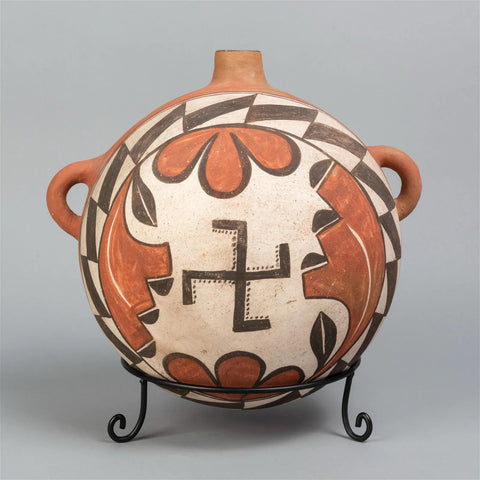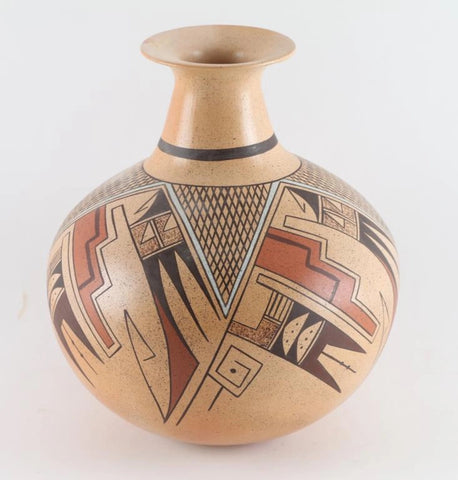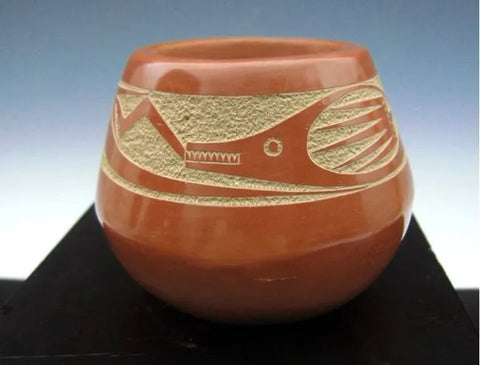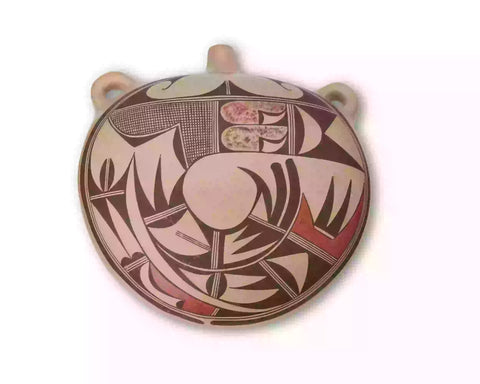
American Indian Pottery : Native American Hopi Pottery Jar by Steven Lucas #71
$ 1,710.00
American Indian Pottery
71. Description: Graceful poly chrome pottery jar with fine avian forms on the shoulder. Very good condition. 6" x 6" .
Steve Lucas is the great -grandson of Nampeyo, grandson of Rachel Namingha Nampeyo and brother of Karen Lucas. He is recognized as one of the premier Hopi potters of today for his outstanding and innovative art work.
He consistently wins blue ribbons and this year he won best of pottery at the Santa Fe Indian Market. His works are created in the traditional ways of Hopi potters and of his great-great grandmother Nampeyo.
Steve uses all natural clay's to hand coil his pottery, natural pigments to create designs and outdoor firing to give his art the wonderful blush that adds much so beauty. Another characteristic of Steve's fine work is the high polished glow which most pieces exhibit. This is achieved through many hours of diligent polishing using a small, smooth stone.
Most of his designs are based on old Sikyatki shards that he studies for inspiration. Steve's work is precise, finely detailed, and nearly perfect in symmetry. Steve has signed with his hallmark mudhead, or koyemsi, along with an ear of corn for his great-grandmother, Nampeyo.
With regard to the most labor intensive step of his highly polished masterpieces, Steve says "Working on the dried, sanded pot, polishing takes several hours, or more if it's a larger pot. We do not use a slip or glaze to achieve the surface finish. "We use a very smooth stone to do the polishing. When you find a good stone, they become very precious and are often passed down, generation to generation. (Source: Ancient Nations)
Pueblo pottery is made using a coiled technique that came into northern Arizona and New Mexico from the south, some 1500 years ago. In the four-corners region of the US, nineteen pueblos and villages have historically produced pottery. Although each of these pueblos use similar traditional methods of coiling, shaping, finishing and firing, the pottery from each is distinctive. Various clay's gathered from each pueblo's local sources produce pottery colors that range from buff to earthy yellows, oranges, and reds, as well as black. Fired pots are sometimes left plain and other times decorated most frequently with paint and occasionally with applique. Painted designs vary from pueblo to pueblo, yet share an ancient iconography based on abstract representations of clouds, rain, feathers, birds, plants, animals and other natural world features.
Tempering materials and paints, also from natural sources, contribute further to the distinctiveness of each pueblo's pottery. Some paints are derived from plants, others from minerals. Before firing, potters in some pueblos apply a light colored slip to their pottery, which creates a bright background for painted designs or simply a lighter color plain ware vessel. Designs are painted on before firing, traditionally with a brush fashioned from yucca fiber.
Different combinations of paint color, clay color, and slips are characteristic of different pueblos. Among them are black on cream, black on buff, black on red, dark brown and dark red on white (as found in Zuni pottery), matte red on red, and poly chrome a number of natural colors on one vessel (most typically associated with Hopi). Pueblo potters also produce un-decorated polished black ware, black on black ware, and carved red and carved black wares.
Making pueblo pottery is a time-consuming effort that includes gathering and preparing the clay, building and shaping the coiled pot, gathering plants to make the colored dyes, constructing yucca brushes, and, often, making a clay slip. While some Pueblo artists fire in kilns, most still fire in the traditional way in an outside fire pit, covering their vessels with large potsherds and dried sheep dung. Pottery is left to bake for many hours, producing a high-fired result.
Today, Pueblo potters continue to honor this centuries-old tradition of hand-coiled pottery production, yet value the need for contemporary artistic expression as well. They continue to improve their style, methods and designs, often combining traditional and contemporary techniques to create striking new works of art.. (Source: Museum of Northern Arizona)




